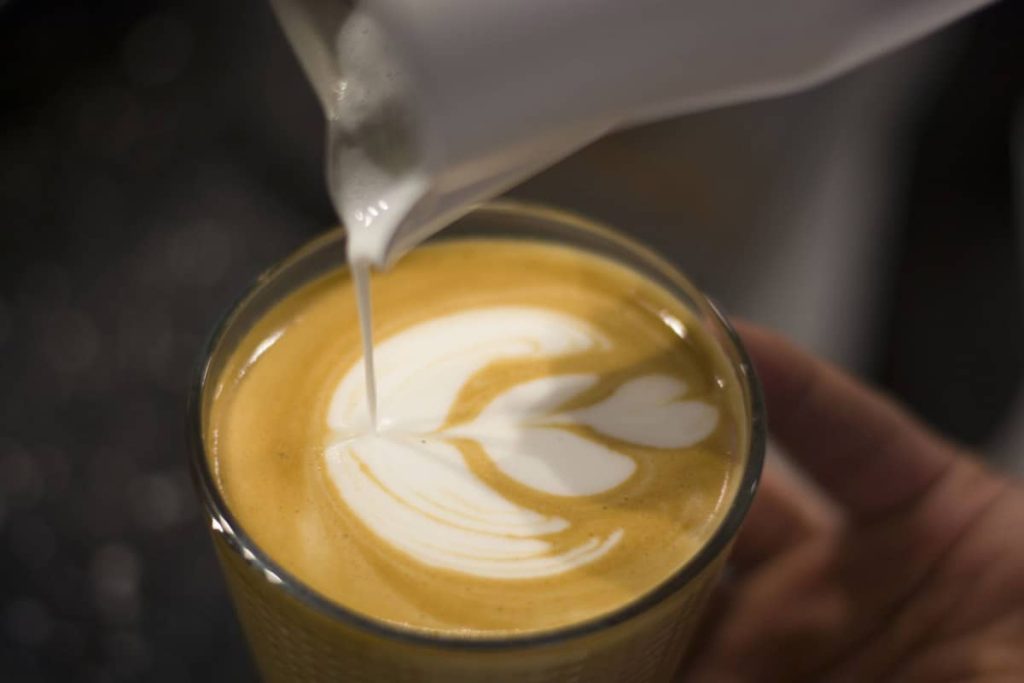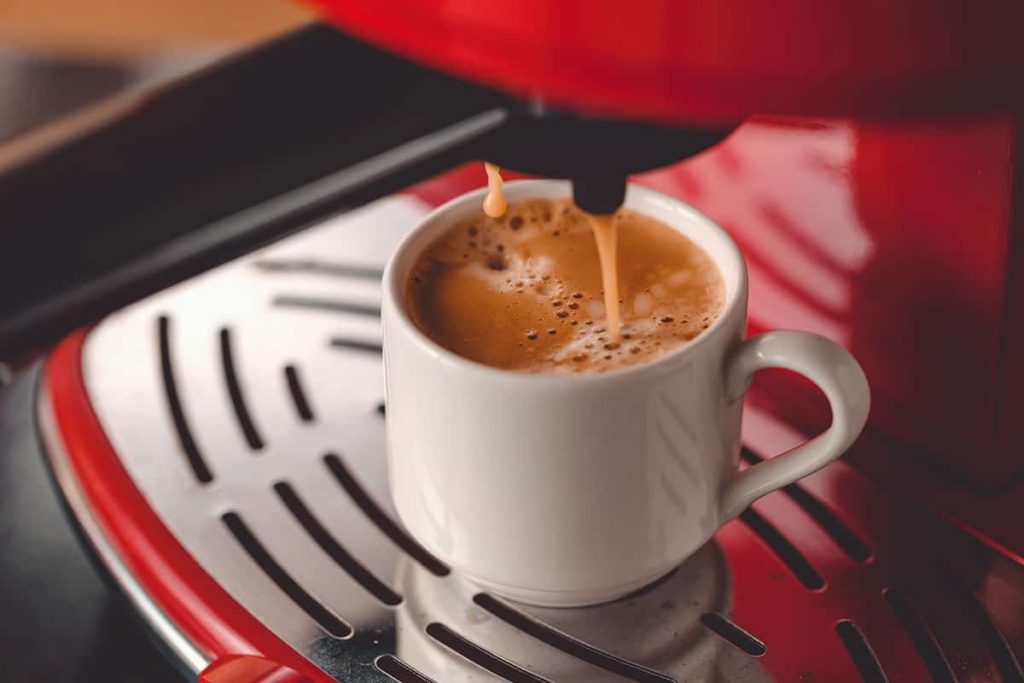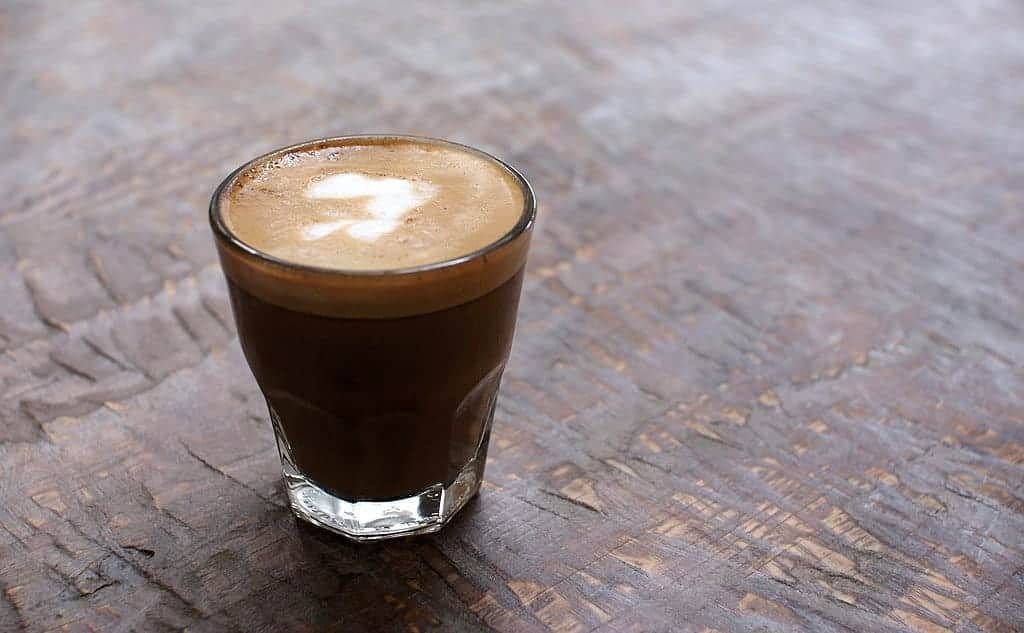What Is a Cortado? How to Make this Espresso-Based Drink

Many coffee drinks (and their quirky-sounding names) come from Italy. But the cortado is a Spanish drink. And like most coffee variants that hail from Spain, the cortado has little to no foam and is rarely served with coffee art on top. But do you know how to make a cortado?
The secrets are warm milk and balance. Cortados are made with one part espresso and one part milk. And while the milk is steamed, it’s served at a lower temperature than typical coffees. Usually, a cortado has two shots of espresso and two shots of milk, 4 ounces total.
What is a Cortado? The Basic Facts
Cortados are sometimes known as gibraltars, which is the cup they were originally served in. These clear glasses have distinct panels and an octagonal shank. The bottom of the glass is quite thick, with a typical capacity of 4.48 ounces. The sides of the glass taper.
A cortado glass – whether it’s a gibraltar or a regular shot glass – should have a diameter of 3 inches at the top and 2-1/8th inches at the bottom. The glass is 3-1/8th inches tall. While this may seem like minutiae, these are key components of genuine cortado coffee recipes.
Cortados barely have any foam on top – it shouldn’t be thicker than your pinkie. But if you’re invested in making coffee art, you’ll need some practice to do it with the typically cooler milk. Not even Starbucks serves bigger cortados, so you can only order a shot or two at a time.
The Origins of Cortado Coffee
You’ll often hear people say that cortado means ‘to cut’. And it does. It’s derived from the Spanish word ‘cortar’. With many coffee drinks, the milk and the coffee stay separate, but with cortado, the milk is fully immersed in the coffee and ‘cuts right through it’. Hence the name.
Cortado coffees were first brewed in the Basque region of Spain. The balanced ratio and complete comingling of coffee and milk make this drink smoother than many espresso variants. It’s beautifully blended and feels intense because the milk is so lightly steamed.
Also, you don’t get sugar, creamer, or additives in your cortado. It’s meant to be drunk neat and quick. And since the glass is so small and the drink is cooler than typical coffees, you can take it down in one gulp. Maybe two. It’s not a drink that lingers.
So how, then, do you make one?
How to Make a Cortado
To begin with, you need a shot of espresso. Espressos are made with particular beans that are ground finer than drip coffee but coarser than Turkish. The drink uses a double espresso as the base with two ounces of steamed milk. A frothing wand is the easiest way to steam the milk.

Pouring is a key part of cortado couture. You want to pour the milk slowly into the espresso. This ensures the drink cuts correctly and that the milk swirls and blends thoroughly into the coffee. And because Gibraltar glasses have thick sides, you are unlikely to scald your fingers.
Espresso machines are the most efficient way to make cortados, but you do have alternatives. If you don’t own an espresso maker, you can use an AeroPress or a Moka Pot. You can even use a French press. And before you learn the espresso technique, start with the beans.
Because espresso grounds need a specific texture – sometimes described as the consistency of fine sugar – it helps if you have an espresso maker with an attached grinder. That way, you can grind your espresso beans into the perfect dark roast, low-acid, scalding double shot.
Step 1: Make the Espresso
To make a solid shot of espresso, you need to account for grind texture, water temperature, and, of course, the quality of your espresso beans. Scorching water shoots through the coffee grounds at extreme pressure. Espresso makers have pumps that do this effortlessly.
But, if you’re using a different kind of coffee maker, you’ll have to work extra hard to get the right water rush. It needs to be close to boiling because espressos must be thick, aromatic, and concentrated. If you’re using a French press, it’ll take a lot of plunging to pressurize it.
To brew a true espresso, you need one ounce of coffee per cup of water. And burr grinders give the best consistency. If you’re using a French press, you may have to sacrifice the espresso texture since French presses need a coarser grind and a longer brewing time.
To make that espresso double, you’ll need 15g (half an ounce) of finely ground espresso beans. If you’re using an espresso machine, loosen the espresso grounds with your finger then tamp the coffee to compress it. For a French press, bloom your espresso instead.
Blooming is when you dampen the ground coffee with a splash of hot water and let it sit for half a minute. This makes your espresso smoother and less bitter. (Only espresso machines count as true espresso because of pressure. Other devices are described as espresso-style.)
If you’re working with a French press, you’ll need to ‘preheat’ it to prevent cracking. Pour some warm water over the glass. If you’re using an espresso machine, do a pass with plain hot water to remove any old grounds, clear out the coffee head, and prime the coffee maker.
Finish up your espresso depending on the kind of coffee maker you’re using. For French presses and AeroPresses, use the plunger. For a Moka Pot, heat the espresso for five minutes. For an espresso machine, after you’ve primed it, press for 30 seconds to extract espresso.
Step 2: Steam the Milk
If your espresso machine has a grinder and a frothing wand, making a cortado is easy. You can do everything all on the same machine!
Instead of using actual milk, you might be tempted to use cream or condensed milk. But that makes a different drink.
A cortado with condensed milk is called a bombon or condensada, while a condensada with cream on top is called a leche y leche. So stick to liquid milk if you want a true cortado. If your espresso maker has a wand, just put your milk in a jug and engage the frother.
Start with cold milk and steam it to 130°F. Reason being, cold milk incorporates air better than warm milk and expands as it absorbs more steam. The jug should be cold, too. Chill the jug in the fridge for half an hour (or a few minutes in the freezer) before pouring in the milk.
Once you start steaming, the jug will begin to get warm in your palms. If you can’t tell the temperature by hand, use a thermometer. Some frothers have a preheat feature that takes a minute or so to warm up, so don’t dunk the steamer in the milk immediately after you turn it on.
Let the frother heat up and fill the frothing jug below the curve of the spout. Frothers work by blending high-pressure steam into your milk. The result can be light, dry, and foamy or thick, dense, and frothy. Cortados need low heat and minimal foam. Ideally, no foam at all.
At 130°F, your milk releases its natural sweetness. And this is crucial because cortados are generally drunk without sweeteners or additives. Curiously, macadamia milk is the best non-dairy frother.
You’ll want to position the frothing wand below the surface of the milk. If the bubbles are too big or the foam too thick, tap the milk jug against the counter. It’ll break up some of the heavier froth. And if you don’t have an espresso maker with a wand on it, you can froth your milk using a whisk, a hand-held frothing wand, or a French press.

Step 3: Clean the Wand
If you’re working with the frothing wand on an espresso maker (or maybe even a standalone steamer), purge the wand before and after use. This pushes clean steam through the wand, getting rid of any milky residue before it evaporates and ‘bakes,’ getting harder to rinse off.
Another reason to purge is the natural way that frothing wands work. Once you switch off the steamer, the pressure instantly reduces. And to fill the vacuum created by the steam, milk gets pulled back up the wand. If this milk ends up inside the espresso maker, that’s messy.
You’d have to take the machine apart and clean out the potentially curdled milk. Or you may have to pay the manufacturer for an expensive maintenance job. Avoid all the drama by purging your wand. It’s also good to stop milk flavors from leaching into each other.
Step 4: Blend the Cortado
Balance is the most important aspect of cortado. The milk and espresso need to come together seamlessly, and there should be little to no froth on top. Hold your cortado cup or glass at an angle and slowly pour in the milk, making sure minimal foam settles on top.
Step 5: Enjoy!
Some say a cortado should be downed like a shot because it’s so small and isn’t piping hot. Others say it should be sipped because it’s sharp and has no sweeteners or additives. While espresso is often served with a super-sweet cookie, cortados might be served with water.
You’re not meant to dilute the drink. You simply swish or sip the water to clear that concentrated cortado coffee taste from your mouth. You can use the safe-booze principle where you sip water after every cortado sip. Or you could gulp the coffee then chug the water.
FAQs About Cortados
It’s not hard figuring out how to make a cortado, especially once you’ve mastered the espresso, which is much harder to brew. But you may still have questions. Here are a few.
Can you use ristretto for a cortado?
The difference between ristretto and espresso shots is concentration. Ristretto shots still use a quarter ounce of coffee per shot (or half an ounce for a double). But the coffee is ground finer than espresso, and it’s extracted with half water. So the coffee shot is stronger. Some people call it a ‘short shot’. A cortado made with ristretto would be harsher on your palate. To help you remember the difference, cortado means ‘cut,’ while ristretto means ‘restrict.’
Are American and Spanish cortados the same?
In theory, yes. In proportion, no. American cortados use a double espresso with two shots of milk. In Spain, they use one shot of espresso with a shot or less of milk. The Spanish coffee to milk ratio is about 1:0.5 compared to the typically American 1:1. But both drinks have minimal froth.
Other countries have variations too. In Saudi Arabia, it’s strong hot or cold black coffee with a dash of milk. In Italy, it’s a 50ml drink (macchiatone) with one espresso shot and minimal milk. Cubans serve it as Cuban espresso (whipped with sugar) and steamed or evaporated milk.
Do coffee shops have in-house cortados?
Yes. Looking at two popular coffee chains, America’s Starbucks cortado has two ristrettos served in a 4oz glass that’s topped with milk. Meanwhile in Europe, Caffé Nero’s cortado has one shot of espresso, two shots of milk, and half a sho’ of microfoam in a 1:2:0.5 ratio.
Is a demitasse the same as a gibraltar?
No. A demitasse is a mini coffee cup that’s 2 to 3 ounces. It’s half the size of a standard coffee cup and is used to serve espresso. A gibraltar is a thick, clear glass that’s about 4.5 ounces and typically used to serve cortados. You’ll pour your espresso into the gibraltar first, then follow with two shots of steamed milk. Swirl the cortado carefully to blend the two liquids.
Is a cortado just a mini flat white?
No. A flat white does have a double shot of espresso, but it has a little more than a double shot of milk, so it’s a heavier drink with slightly less concentrated caffeine.
Also, a cortado has little to no foam, while flat whites have a thicker sheet of foam plus decadent coffee art. The froth used in a flat white is called microfoam. It’s a creamy, fluffy, silky, unbroken foam so you can’t spot any distinct froth or individual bubbles. Flat whites came from Australasia.
Does it matter what kind of milk you use?
No, it doesn’t. Use whatever milk you’re happy with, as long as it’s liquid milk steamed at 130°F. That can include soy, goat, rice, almond, or coconut milk, but it can’t be in powdered form. Non-dairy milks don’t take steam as well as dairy-based milk, but foam isn’t a deal-breaker for cortados. And no, you can’t use a creamer or buttermilk. They’ll shift the texture.
What if the milk is the wrong temperature?
If your milk is too hot, your cortado will have a thick layer of foam, which you don’t want. (Spaniards are not about the foam!) And if it’s too cold, it may blob over the hot coffee instead of smoothly cutting through it and blending properly. So you want your espresso at about 195°F, while the steamed milk hits the coffee at 130°F. And don’t forget to purge!
How About a Cortado Attempt?
Now that you know what a cortado is, try making it. If you can make espresso, then you can make cortado. All you need to do is pour your double espresso into a demitasse or gibraltar, add two shots of lightly steamed milk, and you’re done! It’s a lot quicker and more convenient if you have an espresso maker with a wand.
Owen is a writer and editor at Caffe Streets who considers himself a coffee fanatic. He spends his time researching and testing different coffee beans and brewing methods and sharing what he learns with others.





